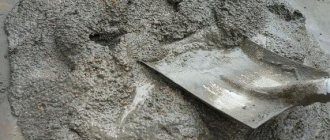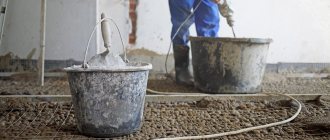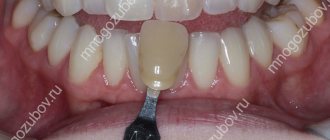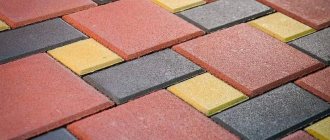Concrete is one of the most popular materials in the construction of houses and non-residential structures. It has great strength, is easy to use and has a low cost. The disadvantage of all mixtures is the need for shrinkage after pouring into the formwork and the risk of cracks and delamination. Thanks to special non-shrinking compositions, it is possible to shorten the preparatory stage and reduce the likelihood of defects. This type of solution is non-toxic and has high protection against corrosion, frost and other adverse external factors. It is used for the restoration of roads, restoration of load-bearing surfaces, staircases and floors. And it's quite simple to do.
What is non-shrinkage and fast-hardening concrete?
In recent years, non-shrinkable concrete has gained great popularity in construction and reconstruction work. The material was developed by a Russian scientist at the end of the 20th century, and the composition is still being refined and improved. Read about the technical characteristics of ShB-5 brick here.
It is produced in the form of a dry mixture, which upon contact with water produces a plastic solution.
Unlike traditional types of concrete, it is characterized by increased strength, minimal risk of cracks and a rapid shrinkage period. This property is possible due to the addition of a large number of superplasticizers to the composition. They increase the strength of cement during compression and demonstrate a rapid reaction with water before hardening begins.
Non-shrinkage concrete, which can be purchased in a store or in production, is conventionally divided into repair and construction. The first type sets faster when diluted and hardens almost instantly.
Composition in bags
Concrete that does not require shrinkage is supplied in bags ranging from 3 to 30 kg. When choosing a specific mixture for construction or repair, you should determine the specifics of the work. Non-shrink mortar can be dry or cast. To fill pre-prepared cracks, it is best to choose the second type. It has the ability to expand, high adhesion, due to this it quickly sets with nearby elements (reinforcement, stone, cement). Such concrete is capable of filling space, strength and sealing efforts. The main area of application is the restoration of horizontal surfaces.
Technical characteristics and GOST
Non-shrinkage concrete is widely used in construction due to its excellent physical characteristics. The table shows the main properties of the material. Find out about fiberglass putty for cars here.
| Characteristic | Meaning |
| Color | grey |
| Fraction size | up to 0.63 mm |
| Preservation of the consistency of the solution | up to 40 minutes |
| Maximum compression density after 28 days | 40 MPa |
| Density | 1400 kg/m3 |
| Adhesion strength to concrete (after 28 days) | 2.0 MPa |
| Frost resistance grade | F300 |
| Waterproof | W 14 |
| Material consumption per 1 m2 (layer thickness – 10 mm) | 15-18 kg |
For the production of non-shrinking compositions, traditional cement grades from B7.5 (M100) to B45 (M600) are used; they are produced in accordance with GOST 7473-2010.
When choosing a specific mixture, you should take into account the grain size of the material and the work requirements.
Self-waterproofing
In practice, in private construction, “folk” means of preparing waterproof cement and concrete are often used. We can recommend the most famous ones. The liquid additive is prepared from lye (0.5 kg) and alum (2.5 kg) in 10 liters of water. For 8 kg of cement you need 1 liter of this additive. Another way is this. Coarse table salt (3 kg) is dissolved in 25 liters of water, after which it is mixed with cement until the consistency of thick sour cream. Finally, the third option - linseed oil (7.5 kg) and paraffin (3 kg) are mixed with cement (12.5 kg), after which everything is mixed with water to the desired state.
When preparing waterproof cements, you need the following tools: construction mixer, scales, shovel, measuring bucket, scoop, spatula, trowel.
Waterproof cement will significantly increase the reliability of structures when exposed to moisture. This composition can be prepared from standard ingredients or with your own hands.
Technologies for the production of non-shrinkable concrete
Unlike traditional mixtures, special additives are used in the production of non-shrinkable concrete. First, prepare the base by mixing cement, sand, crushed stone and water; the proportions of the components depend on the fraction of raw materials, humidity and brand. After this, taking into account the thermal conductivity of sand, superplasticizers are added - they are the ones who give unique qualities to the material. Typically these are calcium aluminate or sulfoaluminate based components.
Some manufacturers use fiberglass or silicon-containing fillers as additional components. These substances enhance the plasticity and rate of hardening of concrete.
Cement
It is impossible to imagine modern construction in St. Petersburg or other cities of the world without the use of cement.
Its use is necessary in the modern world for almost any construction, regardless of the scale and type of main building materials, because every house needs a foundation, and in monolithic structures it turns out to be the main material. Unlike most analogues, it has properties that allow it to harden even in damp conditions, which is especially important in damp areas where no other option is suitable. Prices may depend on many factors, including brand, composition, and even place of production, because Costs vary significantly in different areas.
Composition and its features
Today, the types of cement are quite diverse, with the most common variations based on Portland cement clinker. They provide better performance, and the cost varies very little. The composition includes clay and carbonate mineral rocks, and various mineral additives are used along the way.
Carbonate rocks are divided into:
- Chalk. It is used most often because has excellent characteristics of fragility and softness.
- Marl. An intermediate option between limestone and clay rock, and the properties directly depend on the clay impurities. Use is significantly limited due to the need to conduct additional research at each field.
Clay rocks are divided into:
- Clay. It is a whole mixture of various materials that, when moistened, acquire plastic properties.
- Loam. In addition to clay, it contains largely sand and clay.
- Shale. It has a harder structure, and the rock is capable of stratification into thin layers.
- Loess. Porous rock made from a range of silicates including clay, feldspar, shale, quartz, etc.
- Loess-like loam. The material has the properties of loam and loess, and is therefore considered transitional.
Particular attention should be paid to additives, thanks to which it is possible to improve the properties (hardening speed, elasticity, durability, etc.) of cement. The most commonly used are fluorspar, aluminous, siliceous and clay-containing additives.
Scope of application and which one to choose
A mortar that does not require shrinkage is more often used in the reconstruction or repair of construction projects. Specifics and scope:
- repair, sealing of cracks in concrete and reinforced concrete structures;
- leveling surfaces before installing waterproofing;
- repair of industrial floors;
- restoration of the integrity of culverts;
- strengthening the joints of prefabricated structures, installing fillets;
- placement of anchors in concrete structures;
- installation and strengthening of plumbing equipment, pipes.
When choosing a cement mortar for repairs, you should take into account the volume of cavities, the material of adjacent elements and the physical conditions in the room. Plasticizers in the composition allow the material to be used at high humidity and regular mechanical loads. Several manufacturers produce non-shrink concrete; it may differ in composition, packaging and the presence of additional components. Before purchasing a deep penetration acrylic primer or cement mortar, it is recommended to carefully read the technical specifications.
Bars Consolidation
The manufacturer produces several options for dry concrete that does not require shrinkage. They can be identified by the following markings on the packaging: 102, 111-115. The higher the number, the greater the density of M400 or M114 cement and the better the physical properties of the composition. For example, mixture 114M is resistant to low temperatures and is recommended for repairing reinforced concrete structures and floors. Cement grades B30 and B60 are used for production; it has a medium fraction and quickly sets with water. The price of the composition depends on the technical characteristics, the average cost for 30 kg is 1200 ₽. This material will tell you about the marking of bricks according to GOST 530 2012.
EMACO FAST TIXO
This brand produces a non-shrinking dry mix with a high hardening rate. This is a thixotropic composition; additional components are plasticizers and polymer fiber. Suitable for structures and surfaces made of concrete, stone and cement.
The average price of a bag weighing 30 kg is 2700 ₽.
FAST TIXO can be used at temperatures down to -10 oC, the recommended layer thickness is up to 1 cm. Before starting work, the mixture should be mixed with water using an industrial mixer - this allows for a homogeneous solution. Find out which brick is best for making a stove in your home using this link.
The presence of additional components in concrete reduces not only the time of working with the solution, but also the risk of cracks and delamination during the drying process.
Parade RS 3
This is a fast-hardening cement mixture suitable for repairing concrete, stone and reinforced surfaces in the shortest possible time. The finished composition can be used to close cracks up to 5 mm deep, the recommended filling size is 3 mm. A better result can be achieved by first applying the primer manually and then applying façade putty.
The mixture is produced in paper bags with a moisture-proof liner (weight - 25 kg), average price - 1500 ₽.
Features of dry mixtures
Purchasing concrete in the form of a dry mixture simplifies the storage and transportation of the material. This does not affect its characteristics in any way after preparing the solution:
- increased density;
- high plasticity;
- maximum filler grain size – 10 mm;
- speed of hardening;
- no shrinkage;
- adhesion to cement and steel, maximum adhesion strength is achieved after 28 days;
- good thixotropic properties - the solution does not spread when applied;
- Can be used in drinking water supply systems.
When answering the question of how many buckets are in a bag of cement, it should be taken into account that technical characteristics and properties may vary depending on the manufacturer, the brand of cement used and the fraction of bulk materials in the composition.
Necessity of material
After hardening, any cement has a certain amount of air inclusions, which are microscopic reservoirs for penetrating water; and if the picture is supplemented with capillaries present in the thickness of the material, then this entire system will ensure the permeability of cement and the accumulation of moisture inside, which has a detrimental effect on its properties. Small cavities in the form of pores and microcracks in the structure are caused by excess water in the cement mortar during its laying, insufficient compaction of the layer, deformation and shrinkage processes, cracking under mechanical load, etc.
Concrete composition data table.
To create waterproof cement means to eliminate air inclusions by expanding the material itself or filling them with another substance. Such material is necessary in the construction of structures that are constantly exposed to water or high humidity. Such structures include: foundations in wet soils and plinths with low groundwater; basements, cellars, inspection pits; floor screeds in a number of conditions; walls of pools, wells, tanks and other structures. The use of waterproof cements in such cases will significantly reduce waterproofing measures.
How to make it yourself
If you plan to work on a large area, then it is best to use a concrete mixer - it speeds up the process of preparing the solution and makes it more homogeneous. Step-by-step algorithm:
- Pour water into the concrete mixer at the rate of 4-4.5 liters per 30 kg;
- Turn on the machine, continuously and quickly adding the dry mixture. Achieve uniform texture.
- After mixing, take a technological break for 2-3 minutes and start the device again.
The prepared solution should be used within 30 minutes. If minor repair work is necessary, it is possible to mix the solution in a plastic container using a construction mixer or a paddle attachment. What kind of adhesive is needed for ceiling tiles can be found in this article.
At high ambient temperatures (more than +25 oC), it is recommended to use cold water for mixing; if it is below +10 oC, then cold water.










